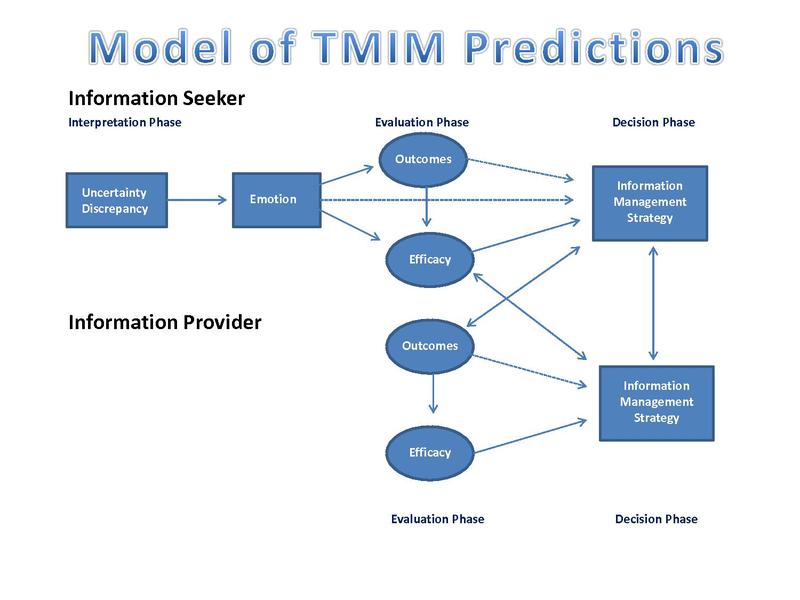3.3 Theory of Motivated Informaiton Management (TMIM)
Born from the frustration with Problematic Integration Theory, Uncertainty Management Theory interepretivist orientation, and desire to incorporate individual experience’s complexity with uncertainty and predictive specificity.
The theory has its basis on:
- Subjective Expected Utility theory (Fischhoff, Goitein, and Shapira 1983)
- social Cognitive theory (Locke and Bandura 1987)
- Theories of bounded rationality (Kahneman 2003): People make suboptimal choice due to other emotions and bias factors.
Due to its laborious process of decision, theory of motivated information management only applies to cases where the person thinks a decision is sufficient important.
Phases:
- Interpretation Phase: recognize the difference (called uncertainty discrepancy) in desired uncertainty and current uncertainty, which mostly produces anxiety, but sometimes hope, anticipation, anger.
- Evaluation Phase: :appraisal of uncertainty impacts assessments made in the evaluation phase", which makes you think about
- Outcome expectancy: what happen if you search for more info
- Efficacy: whether you are able to do the search.
- Communication efficacy: whether a person has the skill to seek info.
- Target efficacy: whether the target of the info search actually has and would be willing to share it.
- Coping efficiency: whether a person could emotionally, relational, or financially deal with what he or she expects to learn.
- Communication efficacy: whether a person has the skill to seek info.
- Outcome expectancy: what happen if you search for more info
- Decision Phase: people are likely to seek info when they expect positive outcomes with high levels of efficacy.
 (picture from (Baxter and Braithwaite 2008))
(picture from (Baxter and Braithwaite 2008))
Note: Information providers go through the same process with only the latter two phases (evaluation and decision).
Research and Practical Application: (e.g., education, health)
Evaluation:
- Benefits:
- Draw attention to communication efficiency, and outcome expectancy
- Good theory: based on testability, heuristics, parsimony, scope condition
- Draw attention to communication efficiency, and outcome expectancy
- Improvement:
- may need to include efficacy’s strength as mediator. Depending on the positivity or negativity of expectations. relationship between outcome expectancies and efficacy, and between outcome expectancies and information seeking may differ
Example:
(Morse et al. 2013) social networks and information seeking influence drug use. From Social Cognitive Theory, and Cognitive Developmental Theory, social norms and peer influence serve as bases for aversive behaviors to be accepted. According to (Wolfson 2000), false consensus support can help explain students overestimate of the positive attitudes of their social network supported by the fact that they are uncertain about their social network’s opinions.
References
Baxter, Leslie, and Dawn Braithwaite. 2008. Engaging Theories in Interpersonal Communication: Multiple Perspectives. SAGE Publications, Inc. https://doi.org/10.4135/9781483329529.
Fischhoff, Baruch, Bernard Goitein, and Zur Shapira. 1983. “Subjective Expected Utility: A Model of Decision-Making.” In Advances in Psychology, 183–207. Elsevier. https://doi.org/10.1016/s0166-4115(08)62199-8.
Kahneman, Daniel. 2003. “Maps of Bounded Rationality: Psychology for Behavioral Economics.” American Economic Review 93 (5): 1449–75. https://doi.org/10.1257/000282803322655392.
Locke, Edwin A., and Albert Bandura. 1987. “Social Foundations of Thought and Action: A Social-Cognitive View.” The Academy of Management Review 12 (1): 169. https://doi.org/10.2307/258004.
Morse, Chris R., Julie E. Volkman, Wendy Samter, Joseph Trunzo, Kelly McClure, Carolynn Kohn, and Joanna C. Logue. 2013. “The Influence of Uncertainty and Social Support on Information Seeking Concerning Illicit Stimulant Use Among Young Adults.” Health Communication 28 (4): 366–77. https://doi.org/10.1080/10410236.2012.689095.
Wolfson, Sandy. 2000. “Students Estimates of the Prevalence of Drug Use: Evidence for a False Consensus Effect.” Psychology of Addictive Behaviors 14 (3): 295–98. https://doi.org/10.1037/0893-164x.14.3.295.